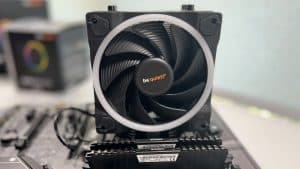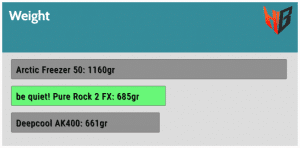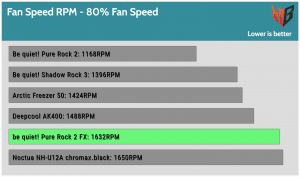The be quiet! Pure Rock 2 FX looks superb, with its ARGB lighting and the black finish. This cooler manages to combine great aesthetics, a fair price and decent performance. Moreover, its installation is a breeze, thanks to the well designed mounting mechanism and the compact dimensions. The latter also provide increased compatibility with mainboards and RAM modules.
be quiet! celebrates its 20th year with the FX products equipped with ARGB lighting. Being able to stay in the highly competing IT business for so long and build such a good name is noteworthy, and kudos to be quiet! for achieving this. When I have to review a product from this brand, either a PSU, a cooler, or a chassis, I expect high quality, good design, and above all, low noise output. be quiet! was the first to set low noise output among its top priorities.
The Pure Rock 2 FX is based on the plain Pure Rock 2 cooler, which is highly popular in budget builds. So its TDP cooling efficiency remains at 150 W, and it has four 6mm heatpipes, which come in direct contact with the CPU’s heatspreader for optimal efficiency. The significant changes are in the fan, where the Pure Wings 2 has been replaced with a Light Wings high-speed fan, which also features ARGB lighting. At 53 euros/dollars or 47 pounds, the Pure Rock 2 FX remains a budget-friendly product, but the price increase over the plain Pure Rock 2 is notable, at 16 euros or 45% more!
Cybenetics Cooler Database- Brand: be quiet!
- Model: Pure Rock 2 FX
- Max TDP: 150W
- Socket Compatibility AMD: AM5 / AM4
- Socket Compatibility Intel: 1700 / 1200 / 2066 / 1150 / 1151 / 1155 / 2011(-3) square ILM
- Fan Model: Light Wings 120mm PWM high-speed
- Fan Bearing Type: Rifle
- Dimensions (L x W x H): 87 x 121 x 155mm
- Weight: 685 gr
- Warranty: 3 years
- Retail price: $52.90 / €52.90 / £46.99
A Look At The Product
The black coating with the fan’s ARGB lighting looks fantastic! It is not easy to find a budget cooler with nice aesthetics.
The four heatpipes are cooled down by a large number of fins. The top plate, which directs airflow through the fins, has good build quality.
There is a pre-installed thermal pad on the cooler’s base, so there is no need to use thermal paste for the first installation. If you want the best possible performance, I suggest removing the thermal pad and using the proper amount of a good thermal paste (e.g., Arctic MX-5).
The Light Wings fan offers increased performance over the plain Pure Rock 2 model and ARGB lighting, which looks nice! The fan uses a rifle-bearing which will easily outlive the provided warranty. A fluid dynamic bearing would be better, but it would also increase the cost. The fan uses a PWM signal for speed control, which is ideal, allowing for more precise control. You will find more details about this fan on the official page.
Weight & Height
The cooler’s weight is low, and its height is average. Most chassis will accommodate without any issues.
Installation
I used an AMD mainboard to try out the Pure Rock 2 FX installation. The whole process is easy, even for inexperienced users.
In AMD mainboards, you don’t have to remove the backplate; you use the stock one, while in Intel ones, you exchange the stock backplate with the provided one. On my AMD mainboard, I first removed the plastic brackets around the socket and installed the corresponding be quiet! brackets.
Don’t forget to remove the protective cover from the cooler’s block! If you don’t do this, expect to see sky-high temperatures once you start the system.
The cooler is secured in place by the mounting bridge, which is screwed to the brackets on both sides.
The last step is to mount the fan using the provided clips. If you want, you can mount an additional fan, which you will have to purchase separately, using the second set of fan mounting clips that be quiet! threw in the bundle.
You can synchronize the fan’s ARGB lighting with your mainboard if the latter supports it. You just need to connect the ARGB connector to the proper header of your mainboard. Once you do that, the Light Wings fan’s lighting will be controlled through your mainboard and synced with the rest of the RGB parts.
I should note that there is no way to adjust the fan’s RGB lighting manually, so you have to use a compatible mainboard. Else you won’t be able to utilize this feature.
Testing Methodology
I use a fully automated, custom-made CPU cooler testing station that can apply any load from 1W to 500W. At the same time, the fan speed can change automatically, so many test scenarios can be applied without supervising the whole procedure, which can last for several hours. Using a simulated load has several advantages, the most important being that you don’t have to rely on a specific CPU, which will eventually become outdated.
On top of that, no CPU can apply precisely the same load level for a prolonged period. There are always power spikes and drops, which affect, of course, the final result. By using an electronic loader, you can apply precisely the thermal load you want, and besides being more accurate, the whole testing procedure is more straightforward. Finally, I only consider the delta differences between the CPU’s block and the ambient temperature in my lab, where the test system is installed.
Watch the following video to learn more about my load testing tool, Jalapeno.
Thermal Performance – Full Fan Speed Comparison Delta
I pushed a lot the compact cooler, and I found out that it offers a notable performance boost over the Pure Rock 2. The new, stronger fan makes a difference.
Noise Output – Fan Speed Percentage and RPM
Even at full speed, the fan doesn’t reach 30 dBA, while it exceeds 2000 RPM.
Noise Output – Comparison Charts
The output noise is low and similar to the noise of the plain Pure Rock 2 cooler’s fan, although the latter spins at lower RPM.
Fan Speed – Comparison Charts
The Light Wings fan has notably higher RPMs than the Pure Wings fan used in the Pure Rock 2. This affects performance, of course.
Time to Steady State
The cooler needs a shorter time to reach a steady state than the Pure Rock 2.
Relative Performance – Full Fan Speed [Jalapeno]
The Pure Rock 2 FX achieves much higher relative performance over the plain Pure Rock 2. Still, the notably more affordable DeepCool AK400 has a considerable performance lead. If you don’t need ARGB, the AK400 is a better bargain.
Performance per dBA – Full Fan Speed [Jalapeno]
This is where the FX shines on Jalapeno, especially with a 500W load.
Performance per Dollar – Full Fan Speed [Jalapeno]
Performance per dollar is not that high. The new fan doesn’t come cheap, increasing the overall cost.
Epilogue
be quiet! decided to release a special version of its budget-oriented Pure Rock 2 cooler. The Pure Rock 2 FX has a faster fan, which offers better performance besides ARGB lighting. The price difference between the FX and plain Pure Rock 2 models is notable at 16 euros, which translates to around a 45% increase. Meanwhile, the product faces serious competition from the more affordable DeepCool AK400, which currently is among the best choices in the sub-50 euros/dollars price range. The Pure Rock 2 FX beats the AK400 in noise output, but most users won’t notice the 1.8 dBA noise difference. It usually takes at least three dBA or more to perceive a notable difference in noise output. That said, the be quiet! Pure Rock 2 FX is among the quietest CPU coolers I have ever tested, even at full fan speed, and it is dead close to the noise output of the plain model, despite the faster fan it uses, thanks to the optimized design of the latter.
Expect a video soon of this product on our YouTube Channel, Hardware Busters International.
Buy it here- Notable performance boost over the Pure Rock 2
- Silent operation
- Compact dimensions
- High build quality
- PWM controlled fan
- ARGB lighting
- Easy installation
- 3-year warranty
- Lacks manual ARGB control. Only through a compatible mainboard
- Large price increase over the plain Pure Rock 2










































